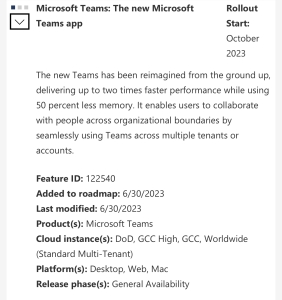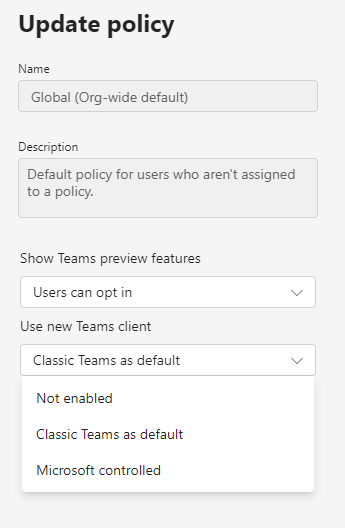There are two new announcements about Microsoft Teams the administrator need to be aware of. These were published on June 30th 2023 via the Microsoft 365 Roadmap and in the Message Center.


Teams administrators can set the New Teams control via an update policy in the Teams Admin Center or using Powershell.

The default value is Microsoft Controlled and with this setting the message center post indicates that the toggle to try the new Teams client will start appearing for business and enterprise users in late July. From mid July administrators will be able to start deploying the new client to PCs and choose to make New Teams the default from late July onwards.
Starting mid September organisations using the default value of Microsoft Controlled for the new Teams client in update policies will see new Teams becoming the default.
You can read the full text of the message center post below, with the links also available for more information.
Since March 2023, we have continued to add features such as third-party, line-of-business (LOB) applications, breakout rooms, and new scenarios such as multi-tenant organization (MTO) to the new Teams experience. Read MC533687 for details for our March announcement. Check The new Microsoft Teams (Preview) for details on upcoming features and support for Government Clouds and platforms such as Mac, VDI, and Web.
This announcement includes three upcoming changes for rolling out the new Microsoft Teams app:
Note: We will continue to honor the admin setting for UseNewTeamsClient under Teams update policies, where admins have already deployed the policy. This is to ensure administrators are fully empowered to manage the rollout of new Teams in a manner that’s right for them.
- We will begin displaying Try the new Teams toggle within the classic Microsoft Teams client where the admin policy setting of UseNewTeamsClient is set to Microsoft default value (Microsoft controlled in the Teams Admin Center (TAC) or Microsoft choice in PowerShell) based on our schedule details below.
- Administrators will be able to directly deploy the new Teams client to PCs in their organization.
- We will begin making new Teams as the default app for classic Teams users where the admin policy is set to Microsoft default (Microsoft controlled in TAC or Microsoft choice in PowerShell) based on our schedule details below. Administrators will be able to manage setting new Teams as the default app for their users.
When this will happen:
Starting mid-to late July 2023:
Microsoft will begin displaying the Try the new Teams toggle within the classic Microsoft Teams client starting in late July 2023. The planned rollout will be:
- Business plans (for example, Business Basic, Business Standard, Business Premium, and Teams Essentials (AAD), etc.): late July-early August 2023
- Enterprise plans (for example, E3, E5, F3, etc.): The new Microsoft Teams desktop client
- Note: Admins who have already deployed the policy to display the toggle or hide the toggle for their organizations will not see any change.
- Administrators can deploy the new Teams client directly to PCs in their organization starting mid-July 2023.
- Administrators can deploy a new setting value to make new Teams the default app for their users starting late July 2023
Starting September 2023:
Microsoft will start making the new Teams the default app starting in late September 2023. The planned rollout will be:
- Business plans (for example, Business Basic, Business Standard, Business Premium, and Teams Essentials (AAD), etc.): late September 2023
- Enterprise plans (for example, E3, E5, F3, etc.): The new Microsoft Teams desktop client
How this will affect your organization:
- Users will start seeing the Try the new Teams toggle in their classic Teams app. Organizations where admins have already deployed the policy to display the toggle or hide the toggle won’t see any changes.
- For bulk deployment, administrators will be able to safely deploy new Teams for their organization without needing to give admin privileges to the users. To learn more about this method, read our documentation here: Bulk deploy the new Microsoft Teams client.
- Administrators can also manage setting new Teams as the default app. To do this, administrators can manage “Use new Teams client” policy and configure “New Teams as default” for their users. To learn more, see our policy page here: Policy settings for deployment.
What you can do to prepare:
Review the resources and timeline and plan your organizations rollout plan for the new Microsoft Teams app.

One thought on “Prepare for New Teams”